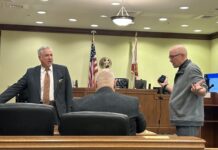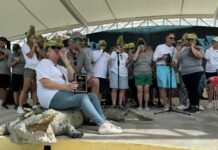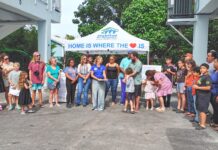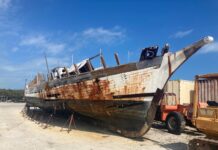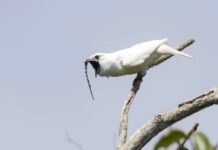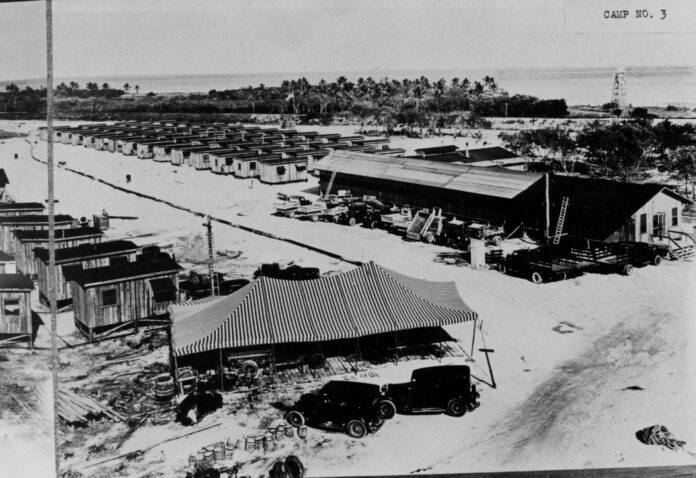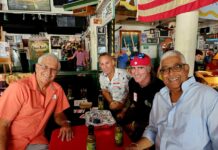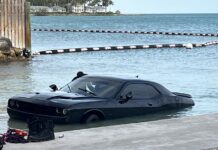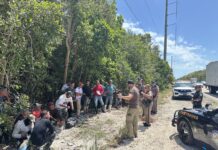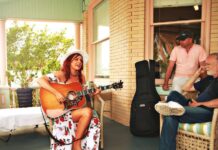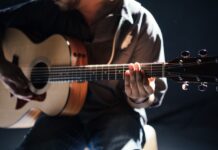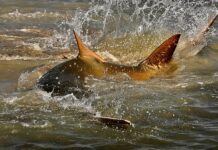Editor’s Note: This is the final in a two-part series on the history behind the arrival of veterans and their contributions to the Florida Keys through the New Deal.
In 1934, President Franklin Delano Roosevelt was working to steer the country out of the Great Depression. One of his New Deal programs brought work projects to the Florida Keys and hundreds of World War I veterans.
Neither Henry Flagler’s railroad nor State Road 4A, the first version of the Oversea(s) Highway, brought the desired number of visitors to Key West. For those driving from the mainland, the road was incomplete and required two trips aboard an automobile ferry.
To make the drive more convenient and bring more traffic to Key West, a series of solid automobile bridges were planned to eliminate the need for a ferry. The veterans were brought to the islands to build the automobile bridges.
They were housed in work camps, two located on Lower Matecumbe Key and one on Windley Key. The work camps were set up with tents and small wooden structures to house the veterans and other men employed for the project. Each of the three camps consisted of about 30 housing tents and could accommodate up to 250 workers, with eight men assigned to a tent for the general labor staff and four men assigned to tents for those with position jobs.
Camp 3 was the first assembled for the veterans and the largest. It was located at the west (or south) end of Lower Matecumbe. Beyond the railroad right-of-way carved through the middle of the island and the bumpy dirt road that was the first version of the Oversea(s) Highway, by 1934, the far end of the island was the only place that had been commercially developed. Because it was there that the highway ended and the automobile ferry began, several convenience businesses had sprung up, including a restaurant serving breakfast and lunch and a gas station.
In addition to housing, equipment and building materials were stored at Camp 3, the only one with a harbor accessible from the Channel 2 and Channel 5 bridges. It is also where the first bridge project was under construction. It would have connected Lower Matecumbe Key to Jewfish Bush Key (Fiesta Key).
Camp 1 was located on Windley Key, just across Snake Creek from Plantation Key. It was the last of the three camps to be established. A fishing lodge on the shore of Snake Creek on Windley Key was used as a hospital facility. Veterans assigned to Camp 1 worked in a nearby quarry, cutting slabs of fossilized coral limestone. Once excavated, the bedrock was loaded into train cars and carried south to Camp 3. The limestone was used to assist in constructing the piers on which the automobile bridge would be supported.
Camp 5, located at the east (or north) end of Lower Matecumbe Key, was used primarily as a housing barracks. The camp lacked some of the amenities of the other camps – a recreation hall, for instance. Camps 2 and 4 were located outside of the Keys, in St. Petersburg and Clearwater.
Progress was being made in the shallows off the harbor at Camp 3. Fill was being dredged up and dumped to create a causeway for the road and the bridge that would roughly parallel the Channel 2 Viaduct on which Henry Flagler’s train steamed, chugged and rolled.
Everything stopped on Sept. 2, 1935, when the Category 5 Labor Day Hurricane raged ashore. The eye of the storm crossed Lower Matecumbe Key to the north and Long Key to the south and battered the Keys with sustained winds in excess of 185 mph and a storm surge of 18 to 20 feet. Barometric readings reached a record-breaking low of 26.35 inches. In Camp 3, 75 vets had gathered in the mess hall. After the wind ripped the roof away, veteran James B. Lindley remembered: “Nearly everyone ran just like a bunch of rabbits. And when we ran out, we ran right into that wind, and after that I don’t remember much what happened to the boys because the wind knocked me right on the banister of the mess hall, and I hit the ground, and I got up, and it knocked me down three times before I stayed down.”
Joseph M. Lydon, a veteran from New York City, was eating dinner in his cabin. According to documents, he said: “We heard the wind, and there were things flying through the air, but we thought we’d be all right till the train got there. Suddenly, the wind tipped the whole cabin over – carried everything out to sea. I got washed away from the cabin somehow. The waves were terrible big things.”
Lydon was lucky. The storm took hundreds of lives — including more than 200 veterans from the work camps.
On Labor Day 1935, Ernest Hemingway was living in Key West. On Sept. 7, 1935, he wrote a letter to his editor and friend, Maxwell Perkins. “We were the first in to Camp Five of the veterans who were working on the Highway construction. Out of 187, only 8 survived. Saw more dead then I’d seen in one place since the Lower Piave in June of 1918.”
He also noted, “We made five trips with provisions for survivors to different places, but nothing but dead men to eat the grub. Max, you can’t imagine it, two women, naked, tossed up into trees by the water, swollen and stinking … recognize them as the two very nice girls who ran a sandwich place and filling-station three miles from the ferry.”
As of the 2023 hurricane season, the 1935 Labor Day Hurricane registers as the most powerful hurricane to ever make landfall on North American soil. The last remnants of the veterans’ work are the eight bridge piers visible from the Channel 2 Bridge. The causeway being filled in has since been covered by mangroves and is known today as Veterans Key.


